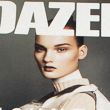'Growing up in San Diego, I wasn’t necessarily into fashion and beauty as much as I was into women. I was into the idea of femininity, and I was brought up by my mom and grandma, so I was surrounded by it. I just thought they were beautiful and inspiring to me. My grandma—up until the day she died, bless her—would put her makeup on every day, and really take her time picking out a look. It was very much, ‘This is what we do—we get ready in the morning.’ Then I started drawing makeup on all of my sister's Vogue covers with pen and make them look the way I wanted them to look. She would always yell at me because I ruined her Vogue s. By middle school, I started getting into the idea of fashion and photography. I remember this one David Sims cover for i-D, it had Kate Moss with her fingers over her eye, and I remember being really fascinated because it was a different kind of fashion. I really related to that whole movement that happened in the '90s—that was really cool.
Back then, makeup didn’t seem like a career choice for me—it was more about fun. In high school, girls always assumed that I knew how to do makeup so they would ask me to do theirs, and I just fell into the role because I liked it. I dropped out of high school to party, but after about a year of that, I got serious about learning and went to get my associate degree. When I was in college and needing money, a friend of mine told me that MAC was hiring a cashier, and I applied there. I remember when the store opened, back in 1996 or '97, I loved it. I thought everyone who worked there was the coolest. I ended up getting the cashier position, and I just stayed and transferred with them when I moved to New York. It was very sales-driven, but I learned how to do makeup on real women because real people came in, with real problems and real issues. Before that, my makeup was less about making someone look beautiful, and more about throwing glitter on our faces or shaving our eyebrows off before a rave. It was whatever you could do to look the most outrageous.
After a while, I left MAC to work for Make Up For Ever. They gave me an amazing position that most people at my age would have been really excited to have, and at first I was. But, to me, it felt more corporate than anything I had done before. I was the National Education Manager, so basically I was writing the educational material for the entire country—they were in the middle of a huge expansion and they needed to train people at Sephora and stuff. But I realized that it wasn’t what I wanted to do, so I left. I was 24, and I felt for sure that if I believed in something enough it would happen. That wasn’t the case. I had to move out of the apartment I was living in because I just couldn't afford it. and I was a wreck—I had no place to go, nowhere to live. I called a friend crying, and she let me stay with her for a few months. It was a real blessing that I had her.
At that time, I was basically just emailing agencies and begging to assist them. I emailed every agency I could think of, just throwing myself out there. I got a lot of rejection emails, but I was persistent. You have to be persistent…you don’t get your big break by mingling or going to parties. You get there by asking the same thing over and over, to as many different people as you can. Eventually, I started working, especially during the show season. It's a great time to assist an artist who you’ve never worked with before because they suddenly need a lot of help. I’d always start emailing a month before the shows, and then just be really aggressive about it for the next two weeks, and I finally got on some shows with younger artists at Streeters. It went from there.
One of the first shows I ever did was really bad—an artist was really short with me, and I internalized it—took it really personally. There were moments when I was sure that I was going to have to move back to San Diego. There were moments when I thought that I might not be good at it or that maybe I wasn’t cut out for it. But after a while, you learn to put your ego aside and, even when people are screaming at you, you just get it done. Working backstage, you have to have that mentality, and when working with different people, you have to get used to their hand and their makeup visually, but also their style of feedback. At the assistant level, you need to be hyper-aware of everything and really look at what the lead artist is doing—which brushes they are using for which product, things like that. I would always try to match the way I did my makeup to exactly the way that they did theirs because there was always a reason they were doing it that way. Ultimately, it came out in the end result.
Little by little, I got to work with the bigger artists I admired, like Aaron de Mey, Diane Kendal, and Pat McGrath. The first time I worked with Pat was a huge accomplishment for me—I was in Milan, and I’d been trying to get on her show team season after season. My friend Frankie Boyd and I used to fly ourselves to Milan and Paris for the shows and stay in these divey hostels, just hoping to work on as many shows as we could. At first we’d barely break even, but we didn’t do it for that—it was for the exposure. We worked the circuit for a couple seasons and then, finally, I got an email from Pat’s booker at midnight the night before the show. They asked if I was available for Dolce & Gabbana the next day, and I said yes. It was for body makeup—not for face. So I went there thinking I was just going to do bodies, but I met her and she asked if I could do a face. I did the face, we clicked, and she basically put me on all of her shows that season. I finished off the season with her, doing Louis Vuitton in Paris.
I left Pat in November 2010. I just felt done. She had some assistants that had been there much longer and stuck around, but I think everyone is different, and everyone knows when they’re done. I was ready to do my own thing. I thought that I needed a break—that I’d have a chance to calm down, rest, and go to San Diego for a month—then come back. Suddenly, things started coming in and it kind of snowballed. Before I knew it, I was able to survive and make money on my own, and it felt very validating.
When you’re young and starting off as a makeup artist, the most important thing to do is editorial because that’s how you identify yourself. At that stage, ad jobs aren’t very exciting…you’re not booking Gucci, you’re booking Kohl's. Catalogue jobs are great because they pay the rent, and you'll meet photographers who can give you some ad jobs later. There’s kind of a give-and-take there. It’s not until later on that you start booking bigger stuff…I think the most exciting ad that I got to work on, for two seasons actually, was Dior with Willy Vanderperre. They were really amazing sets.
When I work with amazing women like Lady Gaga or Rihanna, I don't really get starstruck. For me, the stars are just the people I get to work with. I used to have a list on my computer of people who I wanted to work with—I completed it! Part of the reason I’m able to work with different kinds of people has to do with the fact that I really try to adapt what I’m doing to their style. For something like the glossy, hyper-saturated images that are unapologetically what Mert Alas and Marcus Piggott do, you know that they’re going to make it look amazing and hyper-real and just sick. When I work with Inez and Vinoodh, they can make ugly look so beautiful. I think that once people see how much you’re willing to adapt to fit their style, they’re a bit more responsive to you. Personally, though, I like a little darkness to my work. I've been looking to art and photography lately for inspiration—I love Michaël Borremans work because it has a real, unsettling ease to it that I find really inspiring. And I love Cindy Sherman’s work back in the early days, when it was really twisted, dark, and a bit wrong. Diane Arbus has some eerie things. Even when a shoot is meant to be glamorous, if there’s a bit of creepiness, then it makes for more tension in the picture.
Now, I really like having my team and assistants with me, they’re a huge asset, and I like to make them feel valued. We collaborate well together, and we feed off of each other's creative energy to get a better result. Sometimes a client doesn’t want to pay for assistants—not even one, much less two—but I’ll just insist, depending on the job. For example, I just shot French Vogue with David Sims, and he has a very demanding schedule. When you’re working with David, it’s constant, and you have to be on it. Changes happen really quickly, and it’s kind of like working in a war zone—a really gorgeous war zone, but a war zone nonetheless. The magazine didn’t want me to bring either of my assistants, but I brought both of them because I knew it would be so much less stress for me with both of them there, organized and ready-to-go, so I did it. I try as much as I can to bring both of them.
I get a lot of emails from young makeup artists. It’s tough, because I remember being in that position and really wanting someone to just answer me back and give me an opportunity. I wish that I could give every single one of those people an opportunity, and that I could accommodate everyone, but you just can’t. I forward them to my agent, and she looks at their book and asks them what they’ve done—that way she can filter out the people who she thinks will be strong for me for shows. But I will say that I’m extremely flattered, and I can’t even believe that people are thinking about me like that. I still don’t believe it all the time. Sometimes I worry that the success will go away as quickly as it came. I try not to be concerned about it and just have fun. I got a tattoo on my chest reading, 'This too shall pass.' Nothing lasts forever, whether it’s good or bad. I try to tell myself that when I’m stressing—that it’s going to go anyway, so let it go.”
—as told to ITG
Yadim photographed by Tom Newton.




